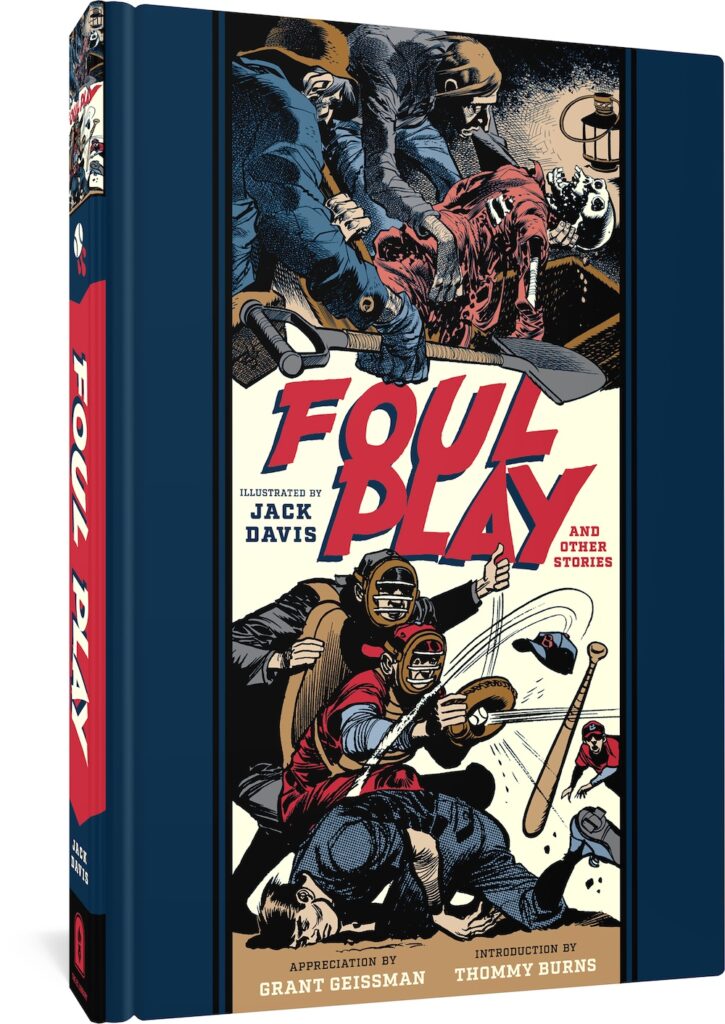‘Foul Play and Other Stories’ Collects the Work of a Notorious Cartoonist With a Gentlemanly Soul, Jack Davis
Influenced by Rembrandt, Daumier, and political cartoonist Bill Mauldin, Davis is among the 20th century’s finest popular artists. Even if your taste in comics doesn’t tend toward the grisly, Davis’s artwork will be familiar.

Cartoonist Jack Davis (1924-2016) was, from all accounts, a gentlemanly soul, but he did have a knack for getting into trouble. When tasked by the United States Postal Service in 1989 to render a stamp commemorating its hard-working men and women, Davis came up with a drawing that some high-placed functionaries worried was insufficiently respectful. Hadn’t anyone told them that Davis was one of “the usual gang of idiots” on the staff of Mad magazine? Irreverence was the soul of the man.
The National Association of Letter Carriers signed off on the illustration even though Davis had surreptitiously included in it a self-portrait — an institutional no-no, seeing as living personages aren’t allowed on stamps. Given the artist’s inglorious history of delineating non-living personages, the USPS got off lucky: Almost four decades earlier, Davis’s art was a cause célèbre in American culture, ultimately prompting a congressional investigation.
What was the nefarious activity in which Davis was engaged? The systematic corruption of America’s youth — at least that was the theory posited by Frederic Wertham in his sensationalistic expose of the comic book industry, “Seduction of the Innocent” (1954).
The first few illustrations in Wertham’s book were cherry-picked from a story featured in “The Haunt of Fear,” “Foul Play.” As written by Al Feldstein, this tale of not-so-divine retribution concerns a minor league baseball team taking revenge upon a rival player. How this is done is — well, it’s novel. Davis endowed its grand guignol upshot with a lurid comic undertow. The story provides the title for a new compilation published by Fantagraphics Books, “Foul Play and Other Stories.”

The reputation of “Foul Play” preceded its printing. Colleagues at the publishing house, Entertaining Comics, looked askance at Feldstein and Davis, despairing at how “a nadir had finally been reached with the baseball story.” Writing in the introduction for “Foul Play and Other Stories,” a comic book historian, Thommy Burns, quotes publisher William Gaines dismissing the infamous strip as “one of our worst … and I’m sorry we did it.” Late in life, Davis stated that “when I looked back … I began to ask — am I still doing something constructive or good?”
However tongue-in-cheek it might be, “Foul Play” is a nasty piece of work. But is it any less guesome than the other contributions Davis made to literary fare like “Vault of Horror” or “Shock SuspenStories”? There are sordid doings aplenty in “Hyde and Go Shriek!” and “Death of Some Salesman,” but, as the titles make plain, there’s also humor, albeit of an often groan-worthy sort. Puns were a stock-in-trade of E.C.’s horror titles, as was alliteration, to wit: “So crawl into the creepy caverns of cadaverous cavortings … [in] this nauseating novelette of eccentric embalming.” Those of us who enjoy wordplay can’t help but take a shine to this type of thing.
Still, over-the-top alliteration is nowhere near as fun, wild, or distinctive as Davis’s artwork. Influenced by Rembrandt, Daumier, and political cartoonist Bill Mauldin, Davis is among the finest popular artists of the 20th century. Even if your taste in comics doesn’t tend toward the grisly, Davis’s artwork will be familiar. His caricatures regularly graced the covers of Time and TV Guide.
During the 1960s and ’70s, he provided the poster art for a number of Hollywood entertainments, including “Kelly’s Heroes” (1970), “Bananas” (1971), “American Graffiti” (1973), “The Bad News Bears” (1976), and, most famously, the staggering array of comedians seen in the poster for “It’s a Mad, Mad, Mad, Mad World” (1963). The encyclopedic and the hyperbolic were Davis’s forte.

Even when Davis played it straight, he was prone to a comic mania: The resulting drawings teeter on caricature and their rhythms are elastic and torsioned. Davis wielded a brush with no small authority, employing cross-hatching techniques to masterful effect.
The splash panel that begins “Uppercut!” carries more detail than a dimestore magazine would seem to warrant. Among the blessings of “Foul Play and Other Stories” is that Fantagraphics has forgone reprinting the comics in color. As seen in black and white, Davis’s noir-like use of contrast and texture isn’t only more apparent, but is made stark and visceral.
Not everything in “Foul Play and Other Stories” is in the horror genre. “The Lonely One” is a surprisingly adult exploration of bigotry during wartime, and Davis’s rare forays into science fiction prove that he was capable of inventing wildly implausible arrays of machinery. Those of us who remember Davis from the pages of Mad should know that this compilation is book-ended by two goofy public service announcements: one for E.C.’s line of magazines; the other posing the immortal question, “Are You A Red Dupe?” The latter is almost as infamous as the title story, but it definitely doesn’t detract from the ghoulishly garish goings-on in this tantalizingly terrifying tome.

